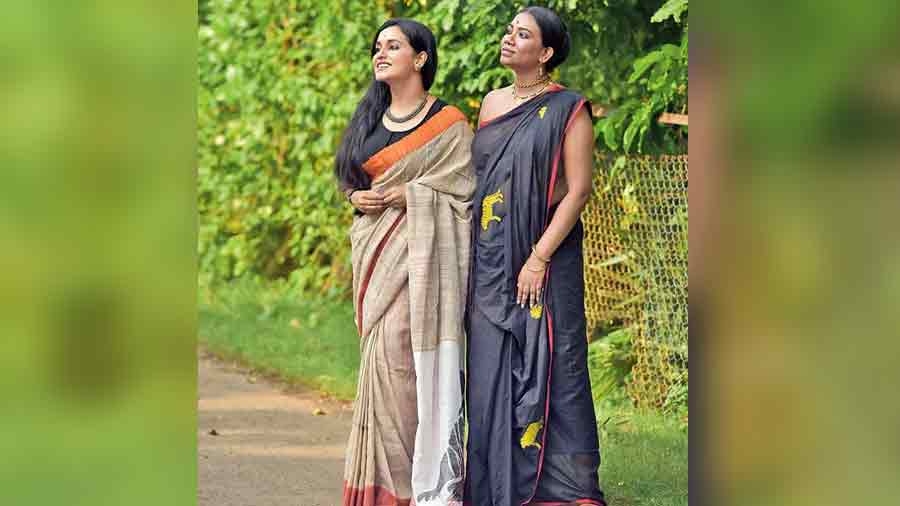A Satyajit Ray classic, the world of animals and a whole lot of nostalgia revival marks high-school biology teacher-turned-textile designer Debjani Bose Ray Chaudhuri’s festive collection for Ghuri by Debjani. She gives us a peek of the range and tells us why she keeps going back to Ray.
Why did you choose Aranyer Dinratri as your festive collection? Is it an ode to the powerful Ray women in the film?
Coming from a zoology and animal behaviour background, I am always intrigued by the beauty of the animal kingdom and it always reflected in my work from the very beginning. We all have some or the other animal power in us, which is deeply ingrained, and human beings are nothing but social animals. Talking about Satyajit Ray, his films and books, sketches, works are something that is now a part of my genetic structure, he runs in my veins. I always go back to his works and films to learn how to work with detailing and how to structure a character. For me, every design is a subject and very much like a human in flesh and blood. So it’s like infusing life into an inanimate object... very much like thakur gora. So it’s not always that I want to give the collection a name, mostly the creations themselves take a shape and form.
If I come to Aranyer Din Ratri, it’s that one film to which I go back to again and again, only to learn technical details of how to construct a character to give it a shape. It’s also same for Rituparno Ghosh’s films. These works are not only mere films to me, it’s like a pool of gems where you can dive in every time and every single time you feel surprised.

Aranyer Dinratri saris with models styled like Aparna and Duli from the 1970 Ray classic.
Does it also have a reference to Vidya Balan’s Sherni and the big cat theme?
Yes, there were a total of four saris that were customised for Vidya for the Sherni promotions. Primarily the one with the Jamdani tiger motif got the limelight. I thought of launching the whole collection as an ensemble adding three more saris to it.
Tell us about the pieces.
There are two Jamdani saris on fine cotton with tiger Jamdani motifs. One is from the Sherni promotions, the other one is from last year’s Shakuntala Devi promotions. There is a fine cotton jaguar motif Jamdani, a tussore sari with a big Jamdani panther on the aanchol, a silk Jamdani with woven Pegasus motifs, an Indonesian batik sari done on the Sherni theme and lastly, an intricately handwoven Shikargarh Benarasi in jungle green having a total of five animal motifs woven in jangla Kadhuwa style.
Which one would you pick for which day?
For Saptami one can choose between the Pegasus or the jaguar; first one can be for the morning and the other for a night out. I would definitely go for the Shikargarh for Ashtami evening as the showstopper. For Navami one can choose between the two tiger Jamdanis, the combination of black, red and yellow colours totally go with Navami. For Dashami, one can keep the batik or else can opt for the revival Shantipuri sari as it’s in a quintessential red-and-white combination.

The Shantipuri sari.
Tell us about the Shikargarh Benarasi…
This Shikargarh sari is a custom-made one as this colour is totally unique, it’s a deep jungle green. Woven on a 3-ply double warp twisted silk base, it’s a jangla jaal Kadhuwa weave sari, which means like an embroidery, the backside threads are continuous without any cuts. The motifs are very closely woven like a carpet, which gives the feel of dense jungle, the zari is a do-ratiya muted gold one that gives it a subtle elegance. Keeping in mind the heavy work on the body, the border is a simple one called a chatai border (like a mat).

The Shikargarh Benarasi.
And, your grandma’s sari that you have revived, perfect for morning festivities…
Yes this one is really special. My mother has kept an almirah full of saris mostly from her wedding trousseau and the ones gifted by my father collected over a span of years. They are real gems and if possible I would definitely try to revive a few from her Bengal collection. She has kept one of my didun’s old saris that’s about 70 years old if not more. It’s a typical Shantipuri with velvet border and has an unusual soft texture, it’s pure love. I took the sari to my weaver and took out threads from the border so that the colour and texture matches. Surprisingly the weaver had to take the help of his dadu to fix the border as their generation only knew the art of weaving those simple but elegant saris with those unusually beautiful borders.
The body is a missing stripe in cotton. That was known as jalchuri dure in olden times, and that in turn gives the softness to the sari.
Let’s finish with the characters in Aranyer Din Ratri. Your faves would be?
From the men, I love the character of Sanjoy, his subtle gestures and fine humour, like when he peeps to look at the mirror last moment to check his looks, or when he says, ‘There goes your Gold Flake’ when Shekhar tries to bribe the forest ranger. Even his doubts and nervousness in front of Kaberi Basu is very genuine. He is timid but I like him the way he is with all his self doubts.
In Ray’s films the women are always of superior moral sensibilities and the men are like children. Women understand the men better and the men are still trying to find themselves. Aparna knows how to handle Ashim’s masculine pride. On one hand she lets him win the memory game, allows him to pay for her at the village fair, but when Ashim asks for her phone number, she writes her number on a currency note, saying — “I couldn’t find any other scrap of paper.”
